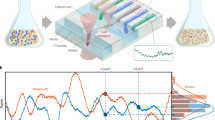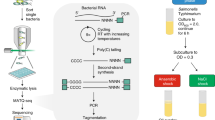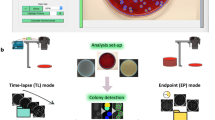Abstract
As bacteria transition from exponential to stationary phase, they change substantially in size, morphology, growth and expression profiles. These responses also vary between individual cells, but it has proved difficult to track cell lineages along the growth curve to determine the progression of events or correlations between how individual cells enter and exit dormancy. Here, we developed a platform for tracking more than 105 parallel cell lineages in dense and changing cultures, independently validating that the imaged cells closely track batch populations. Initial applications show that for both Escherichia coli and Bacillus subtilis, growth changes from an ‘adder’ mode in exponential phase to mixed ‘adder–timers’ entering stationary phase, and then a near-perfect ‘sizer’ upon exit—creating broadly distributed cell sizes in stationary phase but rapidly returning to narrowly distributed sizes upon exit. Furthermore, cells that undergo more divisions when entering stationary phase suffer reduced survival after long periods of dormancy but are the only cells observed that persist following antibiotic treatment.
This is a preview of subscription content, access via your institution
Access options
Access Nature and 54 other Nature Portfolio journals
Get Nature+, our best-value online-access subscription
$29.99 / 30 days
cancel any time
Subscribe to this journal
Receive 12 digital issues and online access to articles
$119.00 per year
only $9.92 per issue
Buy this article
- Purchase on Springer Link
- Instant access to full article PDF
Prices may be subject to local taxes which are calculated during checkout




Similar content being viewed by others
Data availability
Source data are provided with this paper.
Code availability
The code required to process the images (cell segmentation and measurements) are available at https://github.com/manukke/MMsegmenter.
References
Koch, A. L. The adaptive responses of Escherichia coli to a feast and famine existence. Adv. Microb. Physiol. 6, 147–217 (1971).
Morita, R. Y. The starvation-survival state of microorganisms in nature and its relationship to the bioavailable energy. Experientia 46, 813–817 (1990).
Novitsky, J. A. & Morita, R. Y. Possible strategy for the survival of marine bacteria under starvation conditions. Mar. Biol. 48, 289–295 (1978).
Roszak, D. B. & Colwell, R. R. Survival strategies of bacteria in the natural environment. Microbiol. Mol. Biol. Rev. 51, 365–379 (1987).
Lennon, J. T. & Jones, S. E. Microbial seed banks: the ecological and evolutionary implications of dormancy. Nat. Rev. Microbiol. 9, 119–130 (2011).
Navarro Llorens, J. M., Tormo, A. & Martínez-García, E. Stationary phase in Gram-negative bacteria. FEMS Microbiol. Rev. 34, 476–495 (2010).
Buchanan, R. E. Life phases in a bacterial culture. J. Infect. Dis. 23, 109–125 (1918).
Monod, J. The growth of bacterial cultures. Annu. Rev. Microbiol. 3, 371–394 (1949).
Manina, G., Dhar, N. & McKinney, J. D. Stress and host immunity amplify Mycobacterium tuberculosis phenotypic heterogeneity and induce nongrowing metabolically active forms. Cell Host Microbe 17, 32–46 (2015).
Grimbergen, A. J., Siebring, J., Solopova, A. & Kuipers, O. P. Microbial bet-hedging: the power of being different. Curr. Opin. Microbiol. 25, 67–72 (2015).
Casadesús, J. & Low, D. A. Programmed heterogeneity: epigenetic mechanisms in bacteria. J. Biol. Chem. 288, 13929–13935 (2013).
Bódi, Z. et al. Phenotypic heterogeneity promotes adaptive evolution. PLoS Biol. 15, e2000644 (2017).
Balaban, N. Q., Merrin, J., Chait, R., Kowalik, L. & Leibler, S. Bacterial persistence as a phenotypic switch. Science 305, 1622–1625 (2004).
Ackermann, M. A functional perspective on phenotypic heterogeneity in microorganisms. Nat. Rev. Microbiol. 13, 497–508 (2015).
Givskov, M., Eberl, L., Møller, S., Poulsen, L. K. & Molin, S. Responses to nutrient starvation in Pseudomonas putida KT2442: analysis of general cross-protection, cell shape, and macromolecular content. J. Bacteriol. 176, 7–14 (1994).
Davey, H. M. & Winson, M. K. Using flow cytometry to quantify microbial heterogeneity. Curr. Issues Mol. Biol. 5, 9–15 (2003).
Okumus, B. et al. Single-cell microscopy of suspension cultures using a microfluidics-assisted cell screening platform. Nat. Protoc. 13, 170–194 (2017).
Sturm, A. & Dworkin, J. Phenotypic diversity as a mechanism to exit cellular dormancy. Curr. Biol. 25, 2272–2277 (2015).
Mutlu, A. et al. Phenotypic memory in Bacillus subtilis links dormancy entry and exit by a spore quantity-quality tradeoff. Nat. Commun. 9, 69 (2018).
Eldar, A. & Elowitz, M. B. Functional roles for noise in genetic circuits. Nature 467, 167–173 (2010).
Ullman, G. et al. High-throughput gene expression analysis at the level of single proteins using a microfluidic turbidostat and automated cell tracking. Philos. Trans. R. Soc. Lond. B 368, 20120025 (2013).
Norman, T. M., Lord, N. D., Paulsson, J. & Losick, R. Memory and modularity in cell-fate decision making. Nature 503, 481–486 (2013).
Wang, P. et al. Robust growth of Escherichia coli. Curr. Biol. 20, 1099–1103 (2010).
Balaban, N. Q. et al. Definitions and guidelines for research on antibiotic persistence. Nat. Rev. Microbiol. 17, 441–448 (2019).
Moyed, H. S. & Bertrand, K. P. hipA, a newly recognized gene of Escherichia coli K-12 that affects frequency of persistence after inhibition of murein synthesis. J. Bacteriol. 155, 768–775 (1983).
Neidhardt, F. C., Bloch, P. L. & Smith, D. F. Culture medium for enterobacteria. J. Bacteriol. 119, 736–747 (1974).
Konopka, M. C. et al. Cytoplasmic protein mobility in osmotically stressed Escherichia coli. J. Bacteriol. 91, 231–237 (2009).
Barns, K. J. & Weisshaar, J. C. Real-time attack of LL-37 on single Bacillus subtilis cells. Biochim. Biophys. Acta 1828, 1511–1520 (2013).
Kolter, R. Growth in studying the cessation of growth. J. Bacteriol. 181, 697–699 (1999).
Neidhardt, F. C. Bacterial growth: constant obsession with dN/dt. J. Bacteriol. 181, 7405–7408 (1999).
Gefen, O., Fridman, O., Ronin, I. & Balaban, N. Q. Direct observation of single stationary-phase bacteria reveals a surprisingly long period of constant protein production activity. Proc. Natl Acad. Sci. USA 111, 556–561 (2013).
Okumus, B. et al. Mechanical slowing-down of cytoplasmic diffusion allows in vivo counting of proteins in individual cells. Nat. Commun. 7, 11641 (2016).
Amir, A. Cell size regulation in bacteria. Phys. Rev. Lett. 112, 208102 (2014).
Taheri-Araghi, S. et al. Cell-size control and homeostasis in bacteria. Curr. Biol. 25, 385–391 (2015).
Cadart, C. et al. Size control in mammalian cells involves modulation of both growth rate and cell cycle duration. Nat. Commun. 9, 3275 (2018).
Chandler-Brown, D., Schmoller, K. M., Winetraub, Y. & Skotheim, J. M. The adder phenomenon emerges from independent control of Pre- and post-start phases of the budding yeast cell cycle. Curr. Biol. 27, 2774–2783 (2017).
Eun, Y.-J. et al. Archaeal cells share common size control with bacteria despite noisier growth and division. Nat. Microbiol. 3, 148–154 (2018).
Zaritsky, A. & Helmstetter, C. E. Rate maintenance of cell division in Escherichia coli B/r: analysis of a simple nutritional shift-down. J. Bacteriol. 174, 8152–8155 (1992).
Si, F. et al. Mechanistic origin of cell-size control and homeostasis in Bacteria. Curr. Biol. 29, 1760–1770 (2019).
Gonzalez-Pastor, J. E., Hobbs, E. C. & Losick, R. Cannibalism by sporulating Bacteria. Science 301, 510–513 (2003).
Amodeo, A. A. & Skotheim, J. M. Cell-size control. Cold Spring Harb. Perspect. Biol. 8, a019083 (2016).
Sekar, K. et al. Synthesis and degradation of FtsZ quantitatively predict the first cell division in starved bacteria. Mol. Syst. Biol. 14, 1–14 (2018).
Chien, A.-C., Hill, N. S. & Levin, P. A. Cell size control in bacteria. Curr. Biol. 22, R340–R349 (2012).
Kohanski, M. A., Dwyer, D. J. & Collins, J. J. How antibiotics kill bacteria: from targets to networks. Nat. Rev. Microbiol. 8, 423–435 (2010).
Jørgensen, B. B. & Boetius, A. Feast and famine—microbial life in the deep-sea bed. Nat. Rev. Microbiol. 5, 770–781 (2007).
Veening, J.-W., Smits, W. K. & Kuipers, O. P. Bistability, epigenetics, and bet-hedging in Bacteria. Annu. Rev. Microbiol. 62, 193–210 (2008).
Dworkin, J. & Shah, I. M. Exit from dormancy in microbial organisms. Nat. Rev. Microbiol. 8, 890–896 (2010).
Jõers, A. & Tenson, T. Growth resumption from stationary phase reveals memory in Escherichia coli cultures. Sci. Rep. 6, 24055 (2016).
Baba, T. et al. Construction of Escherichia coli K-12 in-frame, single-gene knockout mutants: the Keio collection. Mol. Syst. Biol. 2, 2006.0008 (2006).
Zaslaver, A. et al. A comprehensive library of fluorescent transcriptional reporters for Escherichia coli. Nat. Methods 3, 623–628 (2006).
Schindelin, J., Rueden, C. T., Hiner, M. C. & Eliceiri, K. W. The ImageJ ecosystem: an open platform for biomedical image analysis. Mol. Reprod. Dev. 82, 518–529 (2015).
Schindelin, J. et al. Fiji: an open-source platform for biological image analysis. Nat. Methods 9, 676–682 (2012).
Daszykowski, M. & Walczak, B. in Comprehensive Chemometrics 635–654 (Elsevier, 2009); https://doi.org/10.1016/B978-044452701-1.00067-3
MATLAB and Statistics and Machine Learning Toolbox Release 2018b (The MathWorks Inc., 2018).
Acknowledgements
This work was supported by the National Institutes of Health (NIH) grant R01 AI141966 and DARPA agreement HR0011-16-2-0049. We thank S. Wan for her Python code for extracting TIFF files from the ND2 files; N. Lord for the master of the first mother machine we used; P.-Y. Ho and A. Amir for the discussion of the size-regulation analysis; and P. Gorelik and O. Mazor at the HMS Research Instrumentation Core Facility for assistance in instrument design and fabrication. R. Losick’s and D. Rudner’s laboratories provided the strains and necessary protocols for the B. subtilis experiments. The microfabrication involved in this work was performed in part at the Harvard Medical School Microfluidics Facility and Center for Nanoscale Systems, a member of the National Nanotechnology Coordinated Infrastructure Network (NNCI), which is supported by the National Science Foundation under National Science Foundation award no. 1541959. Center for Nanoscale Systems is part of Harvard University.
Author information
Authors and Affiliations
Contributions
S.B., E.L. and J.P. designed the study. S.B., E.L. and C.B. designed and developed the platform. S.B., S.J.C.-D. and E.L. designed the microfluidic devices and S.J.C.-D. and E.L. constructed the devices. S.B., E.L. and S.J.C.-D. performed the mother machine experiments. C.B. and B.O. helped with the microfluidics-assisted cell screening experiments. S.B. and C.B. developed the image-analysis platform. S.B., C.B., E.L. and J.P. wrote the paper.
Corresponding authors
Ethics declarations
Competing interests
The authors declare no competing interests.
Additional information
Peer review information Nature Microbiology thanks the anonymous reviewers for their contribution to the peer review of this work.
Publisher’s note Springer Nature remains neutral with regard to jurisdictional claims in published maps and institutional affiliations.
Extended data
Extended Data Fig. 1 Operating principle of the single-cell growth-curve setup.
a, Schematic of the dual incubator setup is shown. The incubator in the left houses the growth curve setup (culture flask, shaker, and automated optical density measurement system), and the fresh media reservoir. The commercial incubator on the right houses the microscope and the microfluidic device in which cells are loaded. These two incubators are connected via an insulated duct through which the tubing that carry cells and media go from the flask to the microfluidic device. b, Detailed schematic of the flow-setup – showing the pumps, switches and liquid reservoirs. The box on the left shows the setup used for automatically washing the system before and after every run. A peristaltic pump and a 4-way switch are used to sequentially pump liquid from the reservoirs containing bleach, ethanol, and water to the culture flask or the media reservoir. The box in the center shows components that are housed in the incubator shown on the left of (a). Cells are grown in a baffled-bottom culture flask, which is placed on an orbital shaker. An inline automated OD-meter is used for continuously monitoring the optical density of the culture using a LED-photodiode pair. A set of pumps flow the culture to the OD meter and back, while another one flows it to the microfluidic device. A similar set of pumps are used on the path for fresh media, and both paths can be used interchangeably. The box on the right shows the components housed in the second incubator. These include a set of pinch valves that enable switch from culture to fresh media, and vice versa. We use five 3-way pinch-valves to make sure there is minimal delay in switch, the wash is clean and devoid of any residual bacteria from the culture, and the path is free of bubbles. This design also keeps individual paths isolated and enable wash with bleach, ethanol, and water, while the other path is in use. The media coming out of the final (rightmost) valve can be split using a manifold to flow through different flow-channels in the microfluidic device. d, A detailed schematic of the pinch valve assembly and sequences of steps involved in the media switch is shown. e, Schematic of the bubble-trap is shown to illustrate the principle of operation. Media from the culture flask is dripped into the reservoir (1) and a taken out using another tubing (2) that is placed at the liquid interface to remove bubbles and extra liquid. Due to this design, the media at the bottom of the reservoir stays essentially free of bubbles and is delivered to the mother-machine using a tubing (3) whose inlet is all the way at the bottom of the reservoir. The reservoir has transparent glass-walls (4) and the magnetic stirrer is used to prevent the culture from settling down and to keep it uniform. We use a LED (5) to shine near-IR light through the culture and monitor the transmittance using a photodiode (6) placed in the opposite direction to quantify the optical density of the culture.
Supplementary information
Supplementary Information
Notes 1–19, Figs. 1–14 and Tables 1–3.
Supplementary Video 1
Measurement of dynamic changes in single-cell growth and physiology in E. coli cells over multiple rounds of growth curves. E. coli cells were loaded in the optimized mother machine device, while the content of a culture containing the same strain growing in EZRDM at 37 °C was flowed through it. As the cells in the flask deplete the nutrients and multiply in numbers, the optical density increases and eventually attains a plateau which marks the stationary phase. The cells in the mother machine track the optical density and slow their growth and eventually enter a non-dividing small-sized state. We keep the cells in stationary phase for ~9 h, as in our regular overnight cultures, and then replenish the medium and observe them waking up and restarting the exponential growth and division process. This process was repeated three times for the same batch of cells to check the reversibility of the protocol and can be used to analyse variability and history dependence of observed phenotypes. The images were taken with a ×100 apodized phase-contrast objective every 1 min. The video is played at 48 frames per second.
Supplementary Video 2
E. coli cells carrying a transcription reporter for the master stress-response regulator (PrpoS–GFP) were loaded in the mother machine for monitoring the stress-response dynamics as these cells enter stationary phase by traversing the growth curve and exit upon replenishment of nutrient for two successive rounds. The images were acquired in the GFP channel every 8 min to reduce effects of photobleaching and phototoxicity. The video is played at 6 frames per second.
Supplementary Video 3
Measurement of single-cell growth dynamics of B. subtilis cells along the growth curve. B. subtilis cells were loaded in the corresponding optimized mother machine device and imaged, while the content of a culture of the same cells growing in at 37 °C was flowed through it. Cell lysis is seen as the optical density reaches the plateau and eventually starts to fall possibly for the lysis events. The images were taken with a ×100 apodized phase-contrast objective every 1 min. The video is played at 48 frames per second.
Supplementary Video 4
High-throughput measurement enables monitoring of persister cells in real-time. Here we see one persister cell that does not wake up during the antibiotic (ampicillin 100 μg ml−1) treatment (marked in red in the first part of the video) but wakes up when the antiobiotic is removed and starts to grow when the fresh medium is flowed through (this phase is marked in blue). The other cells either woke up and lysed or did not wake up through the entire process. Images were acquired every 5 min with a ×40 air objective in the red fluorescent protein channel. The video is played at 10 frames per second.
Source data
Source Data Fig. 1
Raw source data for Fig. 1c (bottom).
Source Data Fig. 2
Raw and statistical source data for Fig. 2a,c,d.
Source Data Fig. 3
Raw and statistical source data for Fig. 3a–f.
Source Data Fig. 4
Raw and statistical source data for panels Fig. 4a–d,f,g.
Rights and permissions
About this article
Cite this article
Bakshi, S., Leoncini, E., Baker, C. et al. Tracking bacterial lineages in complex and dynamic environments with applications for growth control and persistence. Nat Microbiol 6, 783–791 (2021). https://doi.org/10.1038/s41564-021-00900-4
Received:
Accepted:
Published:
Issue Date:
DOI: https://doi.org/10.1038/s41564-021-00900-4
This article is cited by
-
Deep model predictive control of gene expression in thousands of single cells
Nature Communications (2024)
-
Emerging tools for uncovering genetic and transcriptomic heterogeneities in bacteria
Biophysical Reviews (2024)
-
Unbalanced response to growth variations reshapes the cell fate decision landscape
Nature Chemical Biology (2023)
-
Dynamic proteome trade-offs regulate bacterial cell size and growth in fluctuating nutrient environments
Communications Biology (2023)
-
Changes in interactions over ecological time scales influence single-cell growth dynamics in a metabolically coupled marine microbial community
The ISME Journal (2023)



